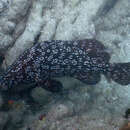Diagnostic Description
(
anglais
)
fourni par Fishbase
Distinguished by the following characteristics: body depth, 2.4-2.6 times in SL; eye diameter much less than snout length, 7.2-8.1 in HL; preopercle serrate, serrae covered by skin; opercular spines not readily visible; slightly concave or straight dorsal head profile; caudal fin rounded or truncate with rounded corners; smooth scales, mostly covered by skin and auxiliary scales (Ref. 089707).
- licence
- cc-by-nc
- droit d’auteur
- FishBase
Morphology
(
anglais
)
fourni par Fishbase
Dorsal spines (total): 11; Dorsal soft rays (total): 18 - 19; Analspines: 3; Analsoft rays: 9 - 10
- licence
- cc-by-nc
- droit d’auteur
- FishBase
Trophic Strategy
(
anglais
)
fourni par Fishbase
A rare species seen in shallow waters of sheltered, turbid coastal rocky or coral reefs (Ref. 9710).
- licence
- cc-by-nc
- droit d’auteur
- FishBase
- Recorder
- Drina Sta. Iglesia
Biology
(
anglais
)
fourni par Fishbase
A rare species seen on shallow waters of sheltered, turbid coastal rocky or coral reefs (Ref. 9710). Morgans (1982, Ref. 6448) reports shoaling behavior in small groups (8 or fewer individuals). Examination of stomach contents reveal fish remains.
- licence
- cc-by-nc
- droit d’auteur
- FishBase
- Recorder
- Estelita Emily Capuli
Importance
(
anglais
)
fourni par Fishbase
fisheries: subsistence fisheries
- licence
- cc-by-nc
- droit d’auteur
- FishBase
- Recorder
- Estelita Emily Capuli
Smooth grouper
(
anglais
)
fourni par wikipedia EN
The smooth grouper (Dermatolepis striolata) is a species of marine ray-finned fish, a grouper from the subfamily Epinephelinae which is part of the family Serranidae, which also includes the anthias and sea basses. It is associated with reefs and is found in the western Indian Ocean.
Description
The smooth grouper has a body which is at 2.4-2.6 times as deep as its standard length[3] The eye has a diameter which is markedly shorter than the length of the snout. The preopercle is serrated with the serrations covered by skin. The spines on the gill cover are not easy to see. The dorsal profile of the head is slightly concave or straight. The caudal fin is rounded or truncate with rounded corners. It has smooth scales which are largely covered by skin and auxiliary scales. There are 11 spines and 18-19 soft rays in the dorsal fin while the anal fin has 3 spines and 9-10 soft rays.[2] The colour of this fish is overall yellowish to reddish brown, becoming paler ventrally. The adults have small, round, dark spots covering the head, body and fins. The juveniles have many small dark brown spots on the head, body and fins, the spots on the body are elongated horizontally while those on the fins are less obvious. The dorsal, anal and caudal fin also have pale spots and there are also pale, irregular blotches of various sizes which vary on visibility too.[3] This species attains a maximum total length of 85 centimetres (33 in) and the maximum published weight is 10.5 kilograms (23 lb).[2]
Distribution
The smooth grouper is found in the western Indian Ocean. Along the African coast its distribution extends from Somalia to Durban in South Africa. It is also found around the Comoros Islands, Madagascar and Aldabra in the Seychelles. It is also found around the southern Arabian Peninsula as far east as the Iranian waters of the Gulf of Oman.It has also been reported from the Red Sea.[1]
Habitat and biology
The smooth grouper is a rare species found on the shallow waters of sheltered, turbid coastal rocky or coral reefs. They have been reported to shoal in small in small groups of up to 8 fishes. Analysis of stomach contents show that they are piscivorus.[2] It is not known whether they form aggregations for spawning.[1]
Taxonomy
The smooth grouper was first formally described as Serranus striolatus in 1867 by the Scottish soldier, diplomat, naturalist and author Lambert Playfair (1828-1899) with the type locality given as Zanzibar.[4]
References
-
^ a b c Barreiros, J. (2018). "Dermatolepis striolata". IUCN Red List of Threatened Species. 2018: e.T44672A100459401. doi:10.2305/IUCN.UK.2018-2.RLTS.T44672A100459401.en. Retrieved 15 November 2021.
-
^ a b c d Froese, Rainer; Pauly, Daniel (eds.) (2019). "Dermatolepis striolata" in FishBase. December 2019 version.
-
^ a b Heemstra, P.C. & J.E. Randall (1993). FAO Species Catalogue. Vol. 16. Groupers of the world (family Serranidae, subfamily Epinephelinae). An annotated and illustrated catalogue of the grouper, rockcod, hind, coral grouper and lyretail species known to date (PDF). FAO Fish. Synopsis. Vol. 125. FAO, Rome. p. 68. ISBN 92-5-103125-8.
-
^ Eschmeyer, William N.; Fricke, Ron & van der Laan, Richard (eds.). "Serranus striolatus". Catalog of Fishes. California Academy of Sciences. Retrieved 22 June 2020.

- licence
- cc-by-sa-3.0
- droit d’auteur
- Wikipedia authors and editors
Smooth grouper: Brief Summary
(
anglais
)
fourni par wikipedia EN
The smooth grouper (Dermatolepis striolata) is a species of marine ray-finned fish, a grouper from the subfamily Epinephelinae which is part of the family Serranidae, which also includes the anthias and sea basses. It is associated with reefs and is found in the western Indian Ocean.
- licence
- cc-by-sa-3.0
- droit d’auteur
- Wikipedia authors and editors
Description
(
anglais
)
fourni par World Register of Marine Species
A rare species seen on shallow waters to depths of 15 m. Morgans (1982, Ref. 6448) reports shoaling behavior in small groups (8 or fewer individuals). Examination of stomach contents reveal fish remains.
Froese, R. & D. Pauly (Editors). (2023). FishBase. World Wide Web electronic publication. version (02/2023).
- licence
- cc-by-4.0
- droit d’auteur
- WoRMS Editorial Board

